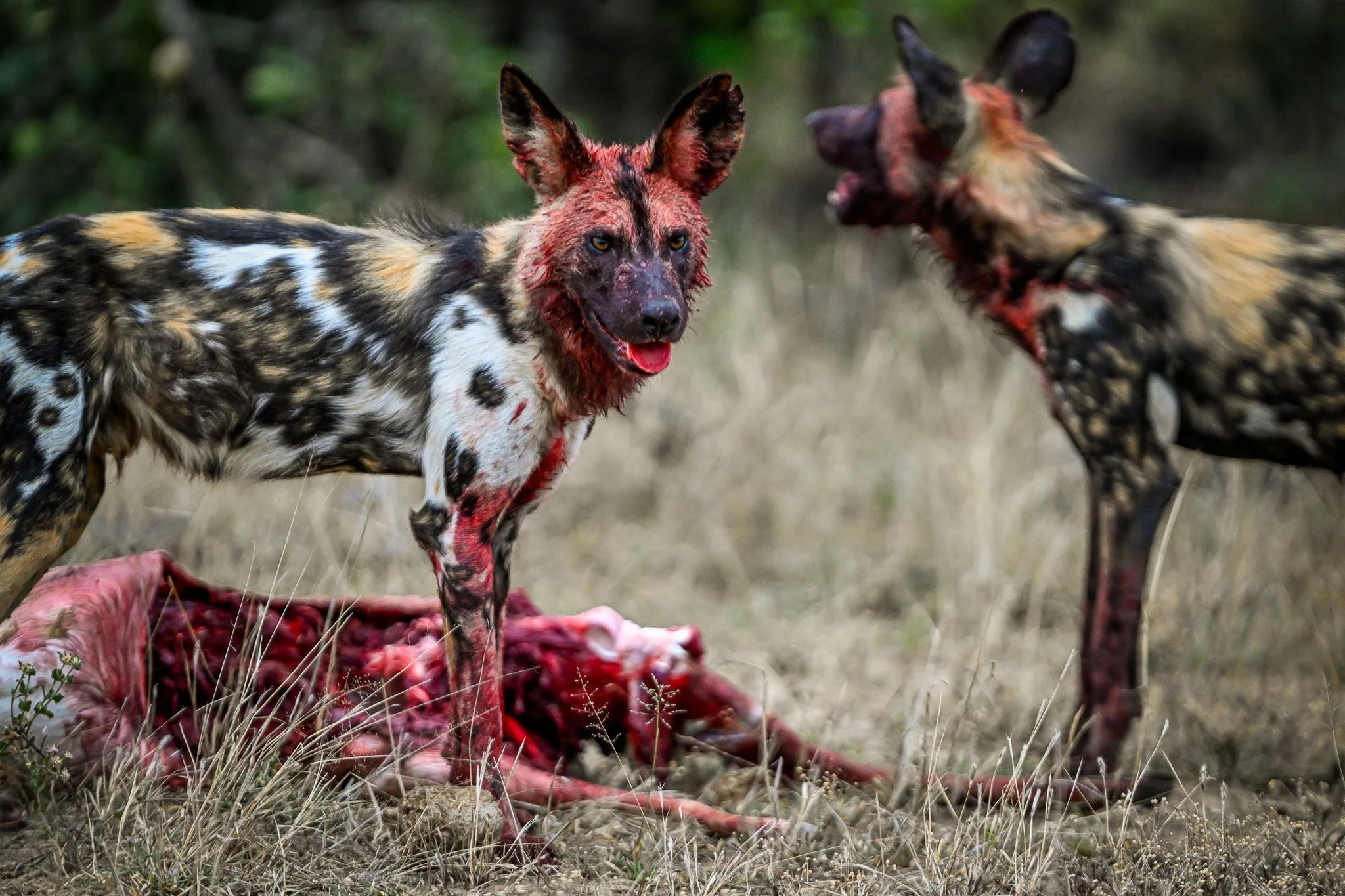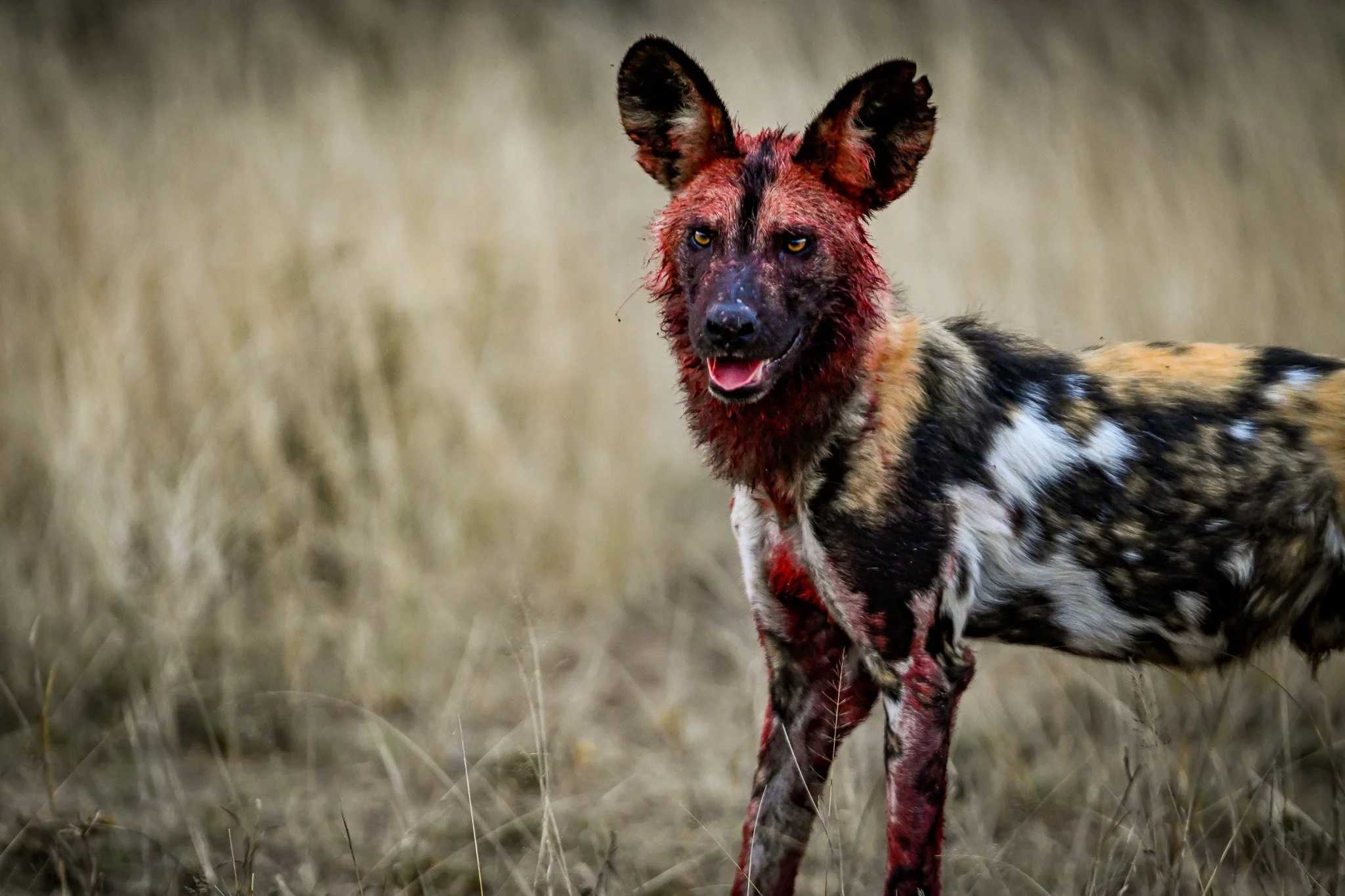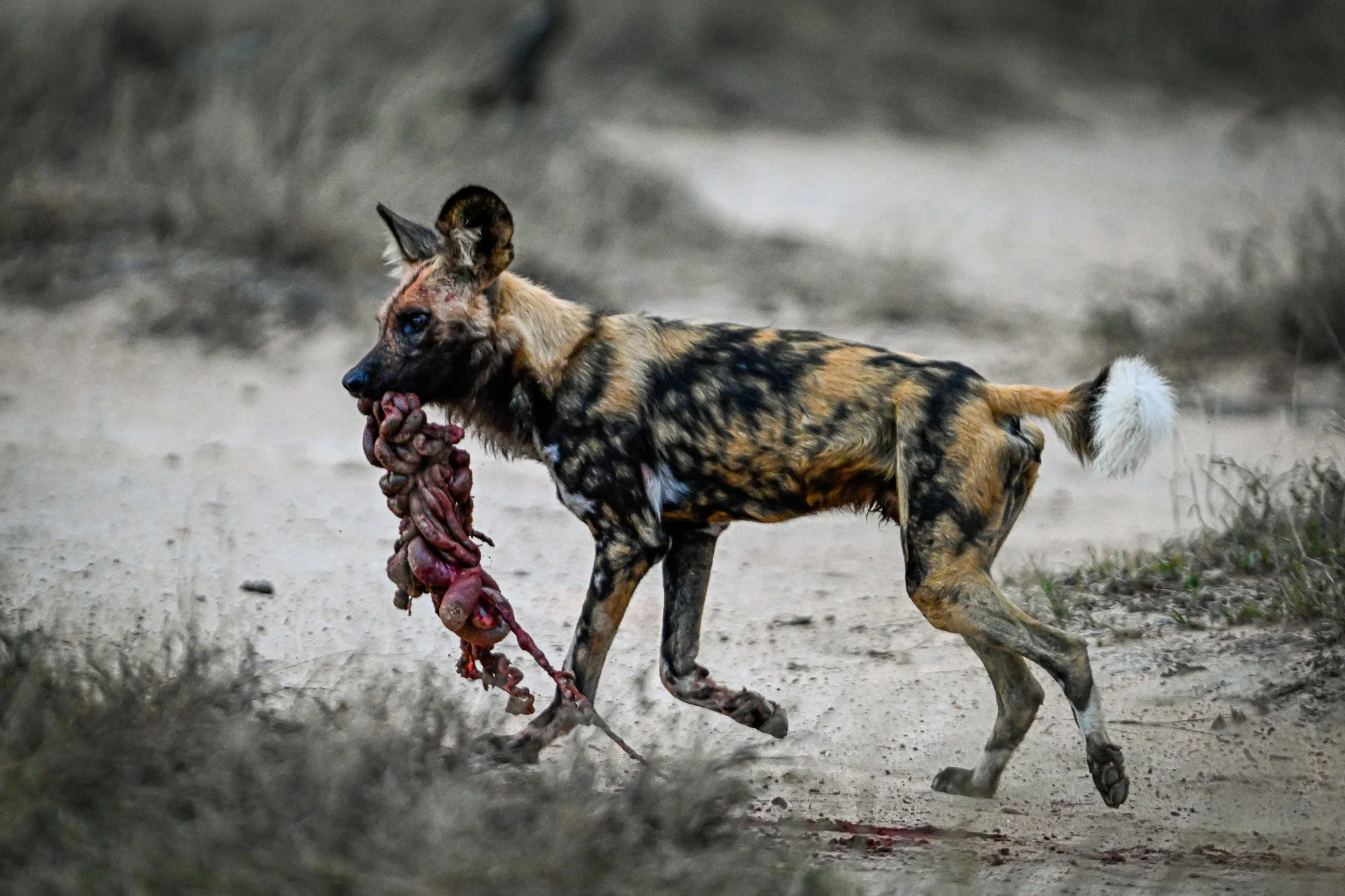African Wild Dogs in Timbavati
Warning: This post contains graphic photos of an impala carcassGuided only by the moonlight, I climb over the side of the Land Rover and settle into its worn seats finished with hot water bottles and blankets. It isn’t even six o’clock, the sun has yet to rise, and it’s the middle of winter in South Africa. It’s cold and I’m tired, but I’m eager to take on the day. This is my third visit to Africa, and while I’ve already encountered so many breathtaking animals, there’s still one that I’ve been persistently searching for – the African Wild Dog.
This time of the year is denning season, so we know where to expect them – an abandoned aardvark hole at the base of a termite mound that they have claimed as their temporary home. Wild dogs hunt at dawn and dusk, so we head over to the den, hoping to arrive just after sunrise to catch them returning from their morning hunt. When the hunting members of the pack return to the den, they will regurgitate food to those who stayed behind, such as the pups, the nursing female/guardian, and any ill or wounded pack members.
As we maneuver our way through the brush of Timbavati Private Nature Reserve we pass giraffe, zebra, and a variety of antelope all widely dispersed across this relatively untouched body of land. The sun has now risen, and I am enjoying the serene landscape when all of a sudden, I’m struck with a robust stench of urine. We’ve arrived.
As we pull into the den site, our noses adapt to the dog’s scent and the swarm of pups steals my attention. I count nineteen of them. Generally, a litter may contain up to sixteen pups, but the average is around eight. The alpha female had a litter of fourteen pups, aged six weeks old. This particular pack is so large with somewhere between fifteen and twenty members that they can support a lot of young, resulting in a bigger litter. Every hunting pack has a dominant pair, typically the only monogamous breeding pair in the group. However, this pack was unique in that the beta female also birthed a litter of pups, hers just four weeks old. In this unusual situation, the alpha female may adopt the young as her own.
It’s fairly easy to tell the litters apart as their difference in age is reflected in their fur. The beta’s younger litter appears simply dark, not yet splattered with various hues of brown and white like the alpha’s litter. Eventually with age, they will all grow into a perfectly unique painted coat.
As we watch the pups play, the hunting members find their way back to the den, a few filtering in at a time. The young mob the returning pack members until they are fed, fighting over chunks of meat that fell to the ground. As the regurgitation continues, we spot a Hooded Vulture on the top of the termite mound overlooking the den. This is not uncommon as vultures are scavengers. Simply put, if there’s meat, whether that be a carcass or regurgitated scraps from these wild dogs, a vulture won’t pass up the opportunity for an easy meal. But every time he hunches his back ready to leap down and steal one of the pup’s bites, he is chased off by one of the many mature dogs who is responsible for the welfare of the young.
A handful of the pups seem to be winding down after their meal and head back into the shaded burrow. Once everyone in the pack is satiated, they begin to get settled and doze off. They’ll most likely rest until dusk when they’ll venture back out for another kill.
The following day, we are counting on that crepuscular behavioral pattern. Our lovely guide, Grant, suggests that we drive in the direction of the den hoping to stumble upon the pack as they advance in search of dinner. So that’s what we do.
First, we spot one dog trotting down the trail with his bat-like ears facing forward. Then four. A dozen. Now there were too many dogs to count. Spotting them isn’t too difficult as their mottled coats are striking to the human eye against the bare African brush. They don’t move in synchrony like a sea of fish, rather they each have their own strong and steady stride several feet apart from one another. With that said, throughout the entire hunt, they are communicating using both body language and contact calls.
The pack is headed in the direction of a large herd of impala when they begin to break off into groups. This is the strategy of the most successful predatory mammal in Africa, with a success rate upwards of eighty percent – split up and reconvene when the job is done. (That job being taking down an impala, of course). We watch as the dogs scatter, charging at the impala herd as they frantically leap away with their hind legs so high over their heads that they take on the form of a “u”.
It is important that we don’t interfere with the hunt, so we sit back for a second as the animals disappear from our sight. We sit in silence, waiting for a single noise to indicate whether any of the wild dog groups were successful. Nothing.
Grant begins driving and for a few minutes we can’t see anything but bush. Suddenly, the tiniest bit of movement catches our attention, and we pull up to two dogs working their way through an impala kill. Even though it had only been a few minutes since the pack split up, these dogs had not only succeeded in taking down the antelope, but they had already removed the stomach, intestines, and lungs and had started feeding on the richer organs like the heart and liver.
Once these two individuals had worked their way through half the carcass, they were full. They lick their lips and jog together, leaving the messy carcass behind. They are off to find the others and bring them back to feed on the defeated impala.
We sit alone with the hollowed-out carcass waiting for the hungry pack’s return. We’re losing light and it’s been longer than we anticipated. I begin to sort through my photos as Grant lifts his binoculars and declares that they’re coming back… The whole pack.
The dogs come running back and begin to finish off the carcass. They need to act fast; it won’t be long before the hyena come and claim the kill for themselves. Ten of the dogs are devouring the body while the rest are taking care of the remaining organs. When it was just the first two dogs that took down the antelope, they were quiet and relaxed. Now, the site of the kill is absolute chaos. Dog chatter fills the air as we watch them dive over one another, ripping the last of the meat off the bone.
A Spotted Hyena is creeping in a bush just feet away from the carcass. Hyena are esteemed scavengers thanks to their remarkable sense of both smell and hearing. Even miles away, a hyena may be able to locate a kill through olfactory and auditory cues. The dogs spot the scavenger, warning him to back off through fierce lunges accompanied by a territorial bark.
However, when a second hyena arrives, the pack immediately surrenders the carcass. While two hyena against a large pack of wild dogs might not seem like a fair fight, the dogs cannot risk a bite from a hyena – it would kill them. The dogs scurry away from the kill and head back to the den where they will share their meal with the young, like we saw the previous morning.
Although it looks like the wild dogs stripped the carcass of nearly all its meat, the hyena are also able to feed on and digest bone, unlike other African predators. We watch as they dismantle the kill, tearing off limbs with ease. The sound of bone crushing echoes through the African thicket as the sun descends, the sky turning blood red in color. Another successful day on safari comes to a close.









